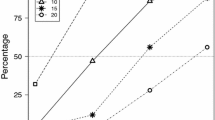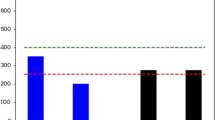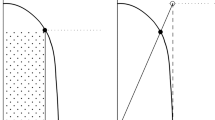Abstract
This paper studies coalitional strategy-proofness of social choice correspondences that map preference profiles into sets of alternatives. In particular, we focus on the Pareto rule, which associates the set of Pareto optimal alternatives with each preference profile, and examine whether or not there is a necessary connection between coalitional strategy-proofness and Pareto optimality. The definition of coalitional strategy-proofness is given on the basis of a max–min criterion. We show that the Pareto rule is coalitionally strategy-proof in this sense. Moreover, we prove that given an arbitrary social choice correspondence satisfying the coalitional strategy-proofness and nonimposition, all alternatives selected by the correspondence are Pareto optimal. These two results imply that the Pareto rule is the maximal correspondence in the class of coalitionally strategy-proof and nonimposed social choice correspondences.
Similar content being viewed by others
References
Bandyopadhyay T (1983a) Manipulation of non-imposed, non-oligarchic, non-binary group decision rules. Econ Lett 11: 69–73
Bandyopadhyay T (1983b) Multi-valued decision rules and coalitional non-manipulability. Two possibility theorems. Econ Lett 13: 37–44
Bandyopadhyay T (1983c) Coalitional manipulation and the Pareto rule. J Econ Theory 29: 359–363
Bandyopadhyay T (1983d) On a class of strictly nonmanipulable collective choice rules. Math Soc Sci 4: 79–86
Barberà S (1977a) The manipulation of social choice mechanisms that do not leave “too much” to chance. Econometrica 45: 1573–1588
Barberà S (1977b) Manipulation of social decision functions. J Econ Theory 15: 266–278
Barberà S, Dutta B, Sen A (2001) Strategy-proof social choice correspondences. J Econ Theory 101: 374–394
Benoît J-P (2002) Strategic manipulation in voting games when lotteries and ties are permitted. J Econ Theory 102: 421–436
Campbell DE, Kelly JS (2000) A trade-off result for preference revelation. J Math Econ 34: 129–141
Ching S, Zhou L (2002) Multi-valued strategy-proof social choice rules. Soc Choice Welf 19: 569–580
Demange G (1987) Nonmanipulable cores. Econometrica 55: 1057–1074
Duggan J, Schwartz T (2000) Strategic manipulability without resoluteness or shared beliefs: Gibbard–Satterthwaite generalized. Soc Choice Welf 17: 85–93
Feldman A (1979a) Manipulation and the Pareto rule. J Econ Theory 21: 473–482
Feldman A (1979b) Nonmanipulable multi-valued social decision functions. Public Choice 34: 177–188
Feldman A (1980) Strongly nonmanipulable multi-valued collective choice rules. Public Choice 35: 503–509
Gärdenfors P (1976) Manipulation of social choice functions. J Econ Theory 13: 217–228
Gärdenfors P (1979) On definitions of manipulation of social choice functions. In: Laffont J (eds) Aggregation and revelation of preferences. North-Holland, Amsterdam, pp 29–36
Gibbard A (1973) Manipulation of voting schemes: a general result. Econometrica 41: 587–601
Kelly JS (1977) Strategy-proofness and social choice functions without singlevaluedness. Econometrica 45: 439–446
Nehring K (2000) Monotonicity implies generalized strategy-proofness for correspondences. Soc Choice Welf 17: 367–375
Nishino H, Cui W, Mizutani M, Satoh Y (1999) The hypercore on social choice problem. J Oper Res Soc Jpn 42: 141–148
Pattanaik PK (1973) On the stability of sincere voting situations. J Econ Theory 6: 558–574
Pattanaik PK (1974) Stability of sincere voting under some classes of non-binary group decision procedures. J Econ Theory 8: 206–224
Pattanaik PK (1975) Strategic voting without collusion under binary and democratic group decision rules. Rev Econ Stud 42: 93–103
Pattanaik PK (1976) Threats, counterthreats and strategic voting. Econometrica 44: 91–103
Peleg B (1984) Game theoretic analysis of voting in committees. Cambridge University Press, Cambridge
Rodriguez-Álvarez C (2007) On the manipulation of social choice correpondences. Soc Choice Welf 29: 175–199
Rodriguez-Álvarez C (2009) On strategy-proof social choice correspondences: a comment. Soc Choice Welf 32: 29–35
Sato S (2008) On strategy-proof social choice correspondences. Soc Choice Welf 31: 331–343
Satterthwaite M (1975) Strategy-proofness and Arrow’s conditions: existence and correspondence theorems for voting procedures and social welfare functions. J Econ Theory 10: 187–217
Author information
Authors and Affiliations
Corresponding author
Rights and permissions
About this article
Cite this article
Umezawa, M. Coalitionally strategy-proof social choice correspondences and the Pareto rule. Soc Choice Welf 33, 151–158 (2009). https://doi.org/10.1007/s00355-008-0351-7
Received:
Accepted:
Published:
Issue Date:
DOI: https://doi.org/10.1007/s00355-008-0351-7




